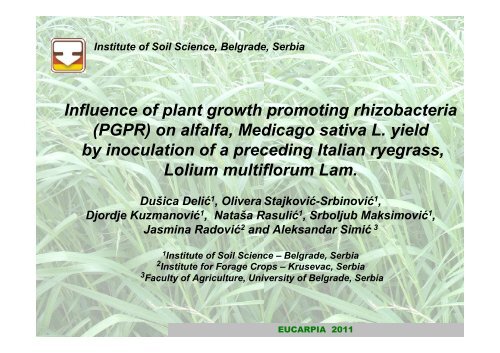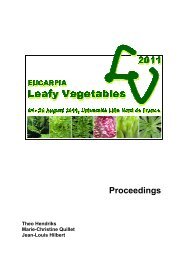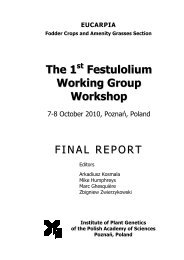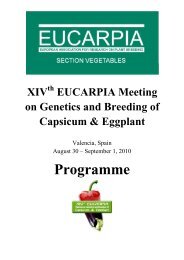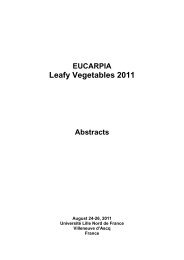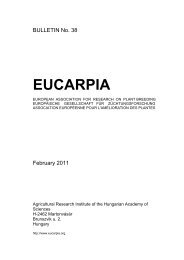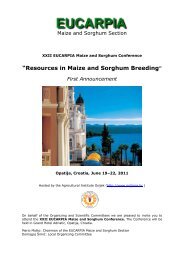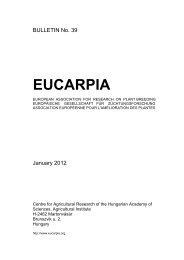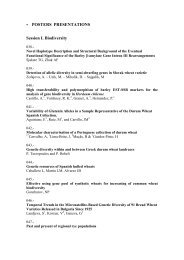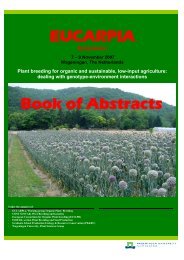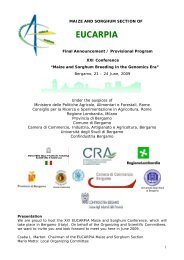Influence of plant growth promoting rhizobacteria (PGPR ... - Eucarpia
Influence of plant growth promoting rhizobacteria (PGPR ... - Eucarpia
Influence of plant growth promoting rhizobacteria (PGPR ... - Eucarpia
You also want an ePaper? Increase the reach of your titles
YUMPU automatically turns print PDFs into web optimized ePapers that Google loves.
Institute <strong>of</strong> Soil Science, Belgrade, Serbia<br />
<strong>Influence</strong> <strong>of</strong> <strong>plant</strong> <strong>growth</strong> <strong>promoting</strong> <strong>rhizobacteria</strong><br />
(<strong>PGPR</strong>) on alfalfa, Medicago sativa L. yield<br />
by inoculation <strong>of</strong> a preceding Italian ryegrass,<br />
Lolium multiflorum Lam.<br />
Dušica Delić 1 , Olivera Stajković-Srbinović 1 ,<br />
Djordje Kuzmanović 1 , Nataša Rasulić 1 , Srboljub Maksimović 1 ,<br />
Jasmina Radović 2 and Aleksandar Simić 3<br />
1 Institute <strong>of</strong> Soil Science – Belgrade, Serbia<br />
2 Institute for Forage Crops – Krusevac, Serbia<br />
3 Faculty <strong>of</strong> Agriculture, University <strong>of</strong> Belgrade, Serbia<br />
EUCARPIA 2011
<strong>Influence</strong> <strong>of</strong> <strong>plant</strong> <strong>growth</strong> <strong>promoting</strong> <strong>rhizobacteria</strong> on alfalfa, Medicago sativa L. yield by inoculation <strong>of</strong><br />
a preceding Italian ryegrass, . Lolium multiflorum Lam.<br />
The aim <strong>of</strong> this study was to improve <strong>growth</strong> <strong>of</strong> Italian<br />
raygrass and provide effective alfalfa nitrogen fixation<br />
under unfavorable soil conditions.<br />
The object <strong>of</strong> the study was to evaluate effects <strong>of</strong> a<br />
preceding Italian ryegrass inoculation with <strong>PGPR</strong> on the<br />
number <strong>of</strong> applied S. meliloti in the soil<br />
as well as quality and quantity <strong>of</strong> Italian ryegrass as the<br />
preceding crop and alfalfa as subsequent crop.<br />
EUCARPIA 2011
<strong>Influence</strong> <strong>of</strong> <strong>plant</strong> <strong>growth</strong> <strong>promoting</strong> <strong>rhizobacteria</strong> on alfalfa, Medicago sativa L. yield by inoculation <strong>of</strong><br />
a preceding Italian ryegrass, Lolium multiflorum Lam.<br />
PLANTS:<br />
Alfalfa cultivar K-28<br />
Italian ryegrass cultivar K-29t<br />
MATHERIAL and METHODS<br />
STRAINS:<br />
Sinorhizobium meliloti: L3Si, 218, 207 and 4148ss:<br />
Azotobacter vinelandi strain Av and Azotobacter chroococum strain<br />
NDD<br />
Enterobacter sp. strain E1<br />
TREATMENTS: inoculated treatments and controls without<br />
inoculation.<br />
POT EXPERIMENT consisted <strong>of</strong> three parts:<br />
• Inoculation <strong>of</strong> Italian ryegrass as preceding crop (in 2009)<br />
• Determination <strong>of</strong> S. meliloti number after ryegrass cutting<br />
• Inoculation <strong>of</strong> alfalfa as subsequent crop in comparison with<br />
common inoculation <strong>of</strong> alfalfa (in 2010)<br />
EUCARPIA 2011
Figure 1. Effect <strong>of</strong> bacterial inoculants on <strong>plant</strong> parameters <strong>of</strong> Italian ryegrass as preceding crop<br />
SDW<br />
mg pot -1<br />
900<br />
800<br />
700<br />
600<br />
500<br />
400<br />
300<br />
200<br />
100<br />
0<br />
Av E1 Ao<br />
NDD<br />
L3Si 4148ss 207 218 Ø1 NØ<br />
Bacterial strains<br />
The highest average values <strong>of</strong> ryegrass shoot dry weight (SDW) were obtained in<br />
inoculated treatments with A. vinelandi strain Av and S. meliloti strain 207 as well<br />
as A. chroococum strain Ao NDD, 752.90, 701.20 and 658.15 mg pot -1 , respectively.<br />
These results indicated that SDW was significantly influenced by inoculation with<br />
these strains in respect to the other inoculated treatments and control-Ø.<br />
EUCARPIA 2011<br />
Total N<br />
mg pot -1<br />
40<br />
35<br />
30<br />
25<br />
20<br />
15<br />
10<br />
5<br />
0<br />
SDW<br />
Total N
Figure 2. Effect <strong>of</strong> previous crop seed inoculation on S. meliloti number in soil the following year<br />
No <strong>of</strong> rhizobia<br />
g-1 soil<br />
100000<br />
10000<br />
1000<br />
100<br />
10<br />
1<br />
9500<br />
3000<br />
14000<br />
140<br />
L3Si 218 207 Ø3**<br />
Number <strong>of</strong><br />
rhizobia<br />
(MPN)<br />
Rhizobial number determined after ryegrass cultivation was increased by 2-<br />
10 times depending on rhizobial strains applied in respect to S. meliloti<br />
number before sowing <strong>of</strong> ryegrass. This inoculation <strong>of</strong> ryegrass together<br />
with subsequent alfalfa inoculation presented double inoculation <strong>of</strong> alfalfa.<br />
EUCARPIA 2011
Figure 3. Effect <strong>of</strong> bacterial inoculants on <strong>plant</strong> parameters <strong>of</strong> alfalfa as subsequent crop<br />
SDW<br />
mg pot -1<br />
6000<br />
5000<br />
4000<br />
3000<br />
2000<br />
1000<br />
0<br />
L3Si 4148 207 218 Ø1 NØ<br />
Bacterial strains<br />
Total N<br />
mg pot -1<br />
Alfalfa double inoculation by the strains L3Si and 218 gave the<br />
highest SDW, 4939.33 and 4216.30 mg pot-1, respectively.<br />
Among alfalfa treatments without preceding crop, strain L3Si<br />
had also the highest effectiveness expressed by SDW (4042 mg<br />
pot -1 ) and total N content (137.04 mg pot -1 ), however<br />
significantly lower than in double inoculated treatments with<br />
the same strain.<br />
200<br />
180<br />
160<br />
140<br />
120<br />
100<br />
80<br />
60<br />
40<br />
20<br />
0<br />
SDW double<br />
inoculation<br />
SDW common<br />
inoculation<br />
Total N double<br />
inoculation<br />
Total N common<br />
inoculation
<strong>Influence</strong> <strong>of</strong> <strong>plant</strong> <strong>growth</strong> <strong>promoting</strong> <strong>rhizobacteria</strong> on alfalfa, Medicago sativa L. yield by inoculation <strong>of</strong><br />
a preceding Italian ryegrass, Lolium multiflorum Lam.<br />
CONCLUSIONS<br />
Our results indicate that Italian ryegrass yield and N<br />
assimilation was increased by inoculation with<br />
A. vinelandi strain Av and S. meliloti strain 207.<br />
Nevertheless, Italian ryegrass seed inoculation with S.<br />
meliloti strains led to increased number <strong>of</strong> S. meliloti in soil<br />
with its low density.<br />
In addition, the year before alfalfa growing Italian ryegrass<br />
seed inoculation with S. meliloti strain L3Si as well as 218<br />
provided abundant number <strong>of</strong> these strains in the soil<br />
and<br />
together with alfalfa common inoculation influenced better<br />
yield <strong>of</strong> alfalfa.<br />
This alfalfa double inoculation shoud be applied in the soils<br />
poor with S. meliloti or without it.<br />
EUCARPIA 2011


